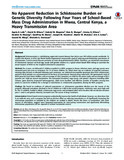| dc.description.abstract | Schistosomiasis is a debilitating neglected tropical disease that infects over 200 million people worldwide. To
combat this disease, in 2012, the World Health Organization announced a goal of reducing and eliminating transmission of
schistosomes. Current control focuses primarily on mass drug administration (MDA). Therefore, we monitored transmission
of Schistosoma mansoni via fecal egg counts and genetic markers in a typical school based MDA setting to ascertain the
actual impacts of MDA on the targeted schistosome population.
Methods:
For 4 years, we followed 67 children enrolled in a MDA program in Kenya. Infection status and egg counts were
measured each year prior to treatment. For 15 of these children, for which there was no evidence of acquired resistance,
meaning they became re-infected following each treatment, we collected microsatellite genotype data from schistosomes
passed in fecal samples as a representation of the force of transmission between drug treatments. We genotyped a total of
4938 parasites from these children, with an average of 329.2 parasites per child for the entire study, and an average of 82.3
parasites per child per annual examination. We compared prevalence, egg counts, and genetic measures including allelic
richness, gene diversity (expected heterozygosity), adult worm burdens and effective number of breeders among time
points to search for evidence for a change in transmission or schistosome populations during the MDA program.
Findings:
We found no evidence of reduced transmission or schistosome population decline over the course of the
program. Although prevalence declined in the 67 children as it did in the overall program, reinfection rates were high, and
for the 15 children studied in detail, schistosome egg counts and estimated adult worm burdens did not decline between
years 1 and 4, and genetic diversity increased over the course of drug treatment.
Interpretation:
School based control programs undoubtedly improve the health of individuals; however, our data show that
in an endemic area, such a program has had no obvious effect on reducing transmission or of significantly impacting the
schistosome population as sampled by the children we studied in depth. Results like these, in combination with other
sources of information, suggest more integrated approaches for interrupting transmission and significantly diminishing
schistosome populations will be required to achieve sustainable control. | en_US |

